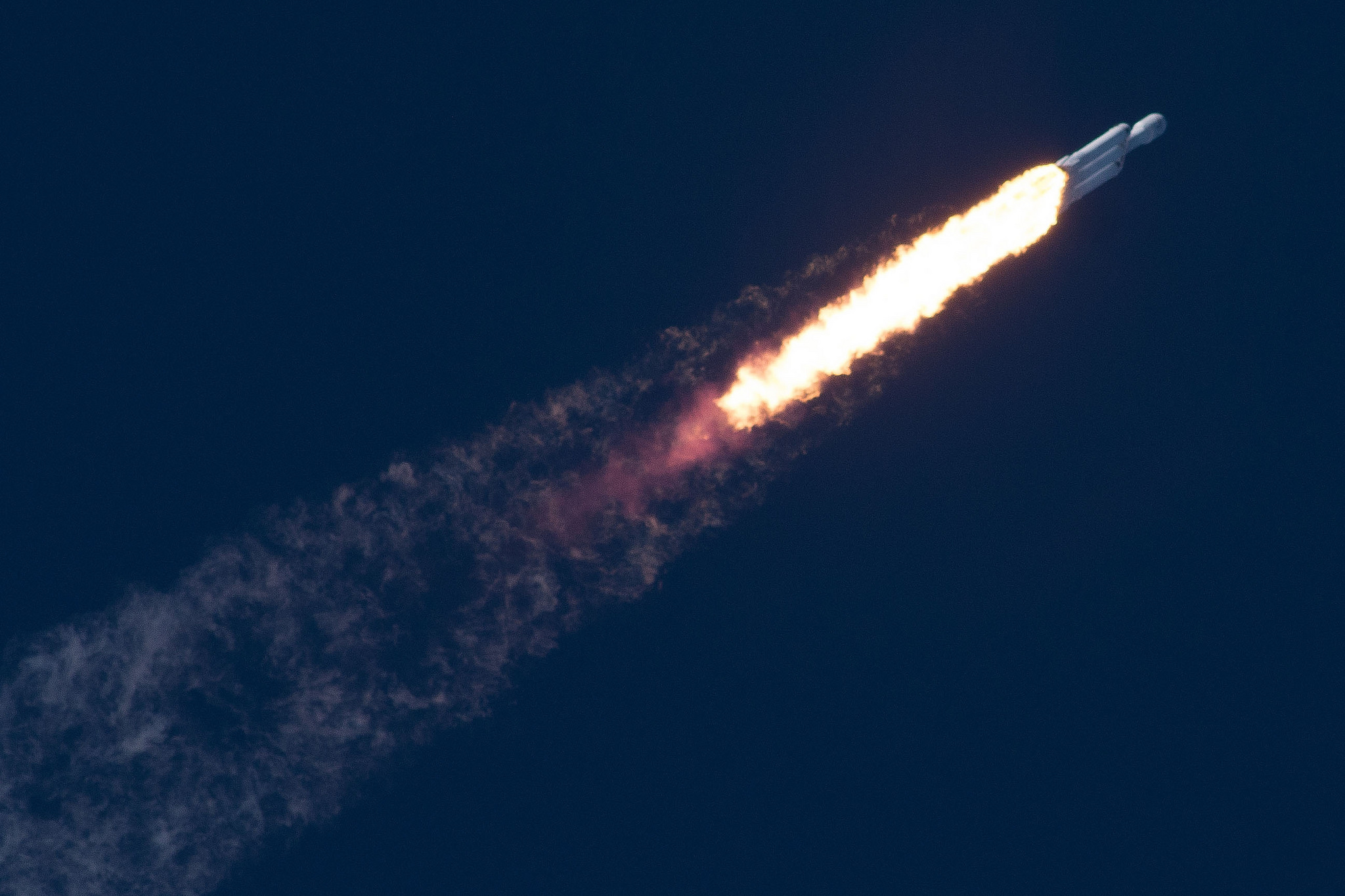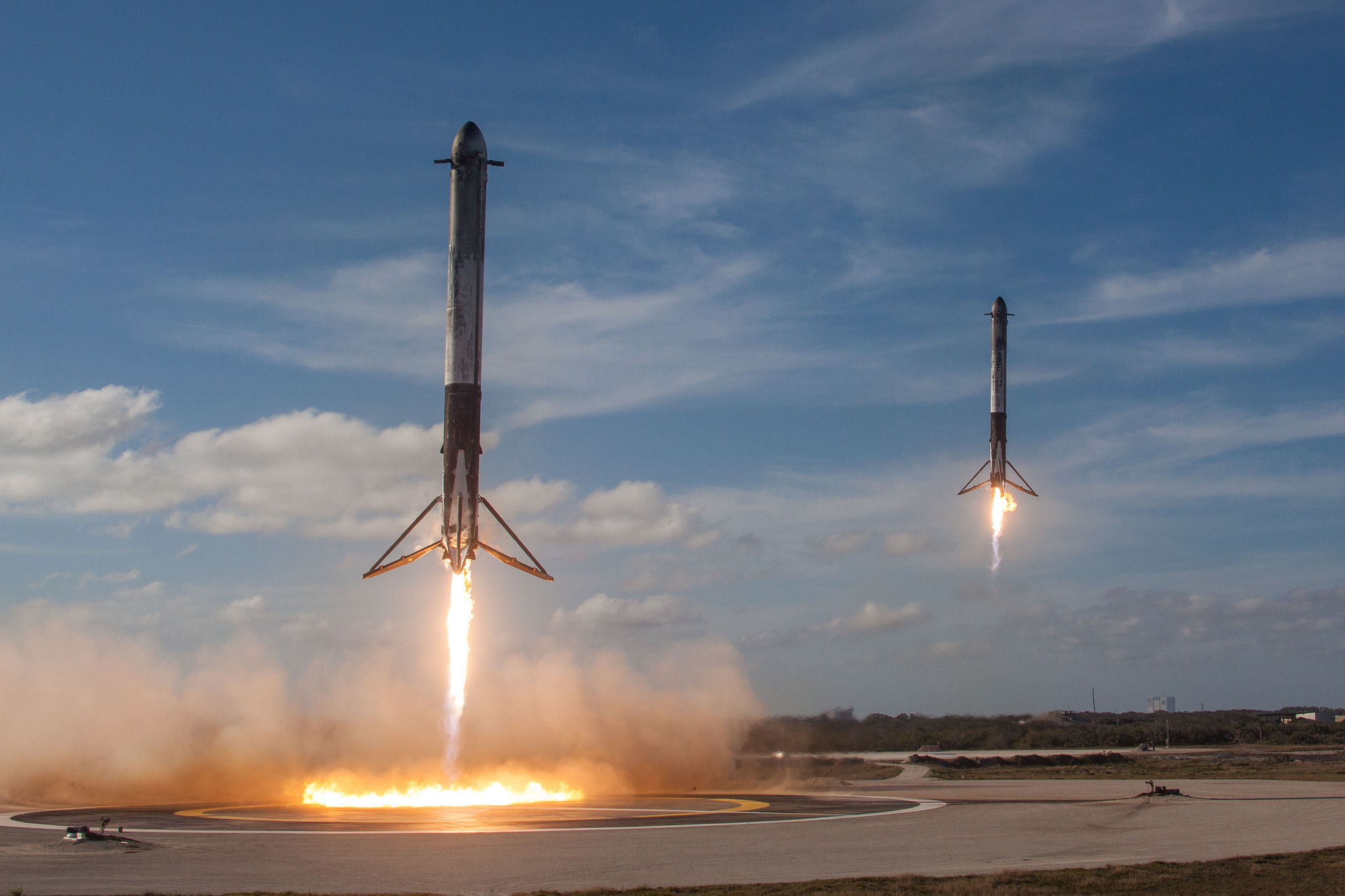Elon Musk Explains Why SpaceX's Falcon Heavy Core Booster Crashed
SpaceX CEO Elon Musk took to Twitter Monday (Feb. 12) to share some new details on last week's Falcon Heavy test flight, including why the massive rocket's core booster crashed. SpaceX is also building a new drone ship for rocket landings at sea, he added.
When SpaceX's Falcon Heavy blasted off last Tuesday (Feb. 6) from NASA's Kennedy Space Center Pad 39A in Florida, the rocket's three first-stage boosters were expected to return to Earth and land much like the company's Falcon 9 rocket stages. The Falcon Heavy's two side boosters landed successfully (and simultaneously) on twin pads at the nearby Cape Canaveral Air Force Station, but the center core crashed and burned.
That core booster, which was expected to land offshore on SpaceX's drone ship "Of Course I Still Love You," crashed when two of three engines did not fire during a final landing burn, Musk told reporters after the launch. The booster missed the landing ship by about 328 feet (100 meters) and hit the water at 300 mph (484 km/h), damaging thrusters on the nearby droneship, Musk has said.
On Monday, we learned a bit more in Musk's Twitter posts. The two engines did not fire because they ran out of ignition fluid, Musk said.
"Not enough ignition fluid to light the outer two engines after several three engine relights," Musk wrote. "Fix is pretty obvious."

That suggests a fix might involve simply adding more ignition fluid, though Musk did not elaborate.
Musk did share one tantalizing tidbit about future Falcon Heavy booster landings: SpaceX is building a third drone ship for offshore rocket landings.
Get the Space.com Newsletter
Breaking space news, the latest updates on rocket launches, skywatching events and more!
Its name? "A Shortfall of Gravitas."
The ship appears to be named in honor of the fictional spaceship "Experiencing A Significant Gravitas Shortfall" in the science fiction books "Look to Windward" and "Matter" by the late author Iain M. Banks. SpaceX's other two drone ships —"Of Course I Still Love You" and "Just Read The Instructions" — are also named for ships mentioned in Banks' Culture novels.
"A Shortfall of Gravitas" is under construction now and will join "Of Course I Still Love You" in Florida to support offshore landings of Falcon Heavy side boosters, Musk wrote. "Just Read The Instructions" is used for Falcon 9 landings after launches from SpaceX's pad at California's Vandenberg Air Force Base.
SpaceX has also built another ship with giant metal arms to catch the protective payload fairings (or nose cone halves) on its rockets before they fall into the sea. You can see a picture of it here. Musk has said in the past that SpaceX's fairings cost about $5 million, so catching them for reuse could be a significant savings.
"It's like a giant catcher's mitt, in boat form," Musk told reporters after the Falcon Heavy launch. SpaceX could try to capture a falling Falcon rocket fairing sometime this year, he added.

In the meantime, SpaceX still has a full slate of Falcon 9 and Falcon Heavy launches on tap in 2018. The company's next launch is scheduled for Saturday (Feb. 17) from Vandenberg Air Force Base. It will use a Falcon 9 rocket to launch the Paz Earth monitoring satellite into orbit for Spain.
At least two more Falcon Heavy missions are on the docket for this year, along with the many Falcon 9 missions for satellite customers and NASA, which uses SpaceX's Dragon cargo ships to deliver supplies to the International Space Station.
SpaceX is also building a crewed version of Dragon to fly astronauts for NASA. The first test flight of that ship on a Falcon 9 rocket is also expected in 2018.
Email Tariq Malik at tmalik@space.com or follow him @tariqjmalik and Google+. Follow us @Spacedotcom, Facebook and Google+. Original article on Space.com.
Join our Space Forums to keep talking space on the latest missions, night sky and more! And if you have a news tip, correction or comment, let us know at: community@space.com.

Tariq is the Editor-in-Chief of Space.com and joined the team in 2001, first as an intern and staff writer, and later as an editor. He covers human spaceflight, exploration and space science, as well as skywatching and entertainment. He became Space.com's Managing Editor in 2009 and Editor-in-Chief in 2019. Before joining Space.com, Tariq was a staff reporter for The Los Angeles Times covering education and city beats in La Habra, Fullerton and Huntington Beach. In October 2022, Tariq received the Harry Kolcum Award for excellence in space reporting from the National Space Club Florida Committee. He is also an Eagle Scout (yes, he has the Space Exploration merit badge) and went to Space Camp four times as a kid and a fifth time as an adult. He has journalism degrees from the University of Southern California and New York University. You can find Tariq at Space.com and as the co-host to the This Week In Space podcast with space historian Rod Pyle on the TWiT network. To see his latest project, you can follow Tariq on Twitter @tariqjmalik.









